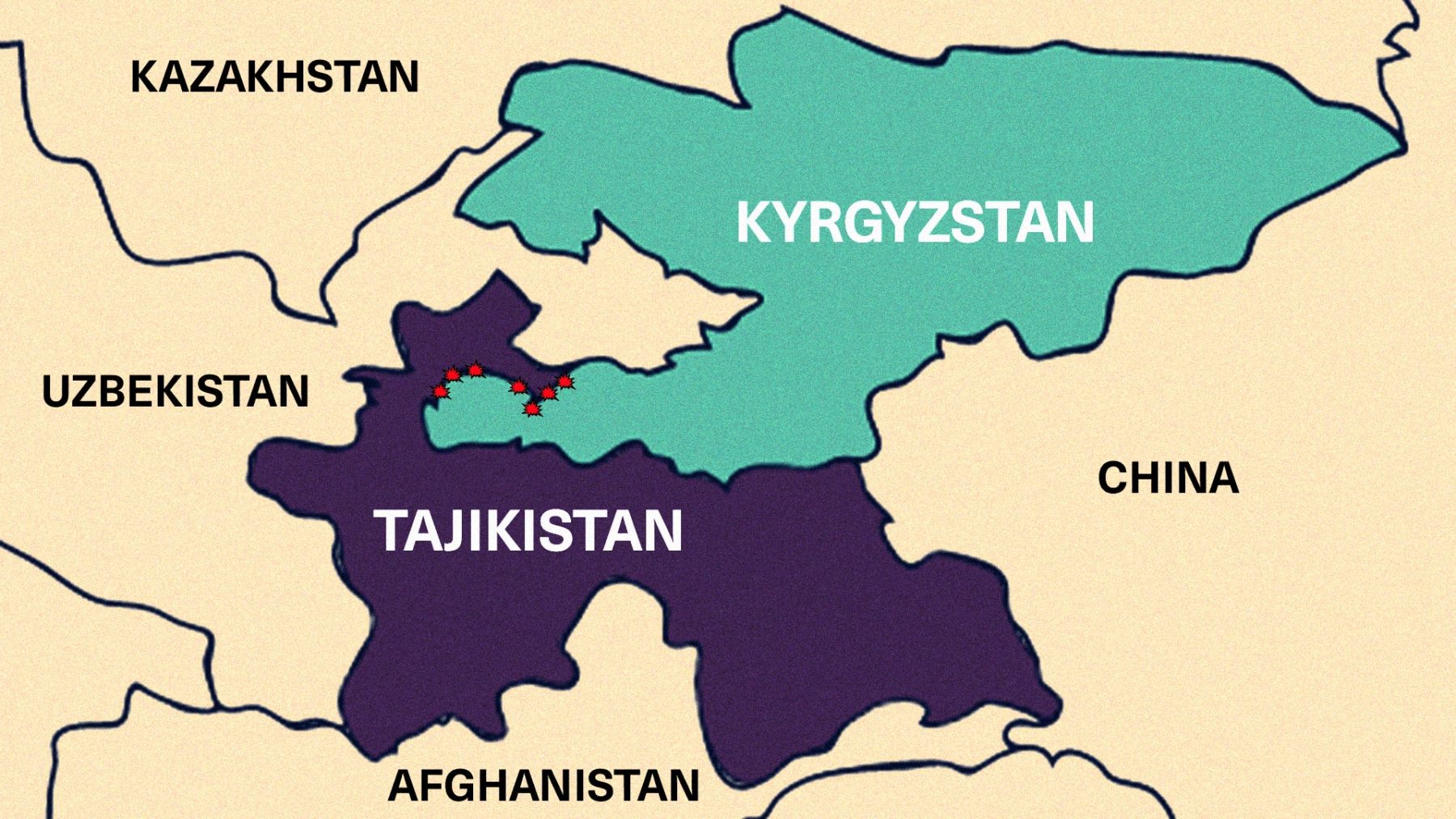Fighting on the border between Kyrgyzstan and Tajikistan marks a steep jump not only in the intensity of violence but devastating distance between the countries’ digital communication skills
Fighting on the border between Kyrgyzstan and Tajikistan marks a steep jump not only in the intensity of violence but devastating distance between the countries’ digital communication skills
On September 16, Ulan’s phone vibrated nonstop with bad news from Batken, Kyrgyzstan’s southernmost province. Kyrgyzstan’s armed forces had sent drones in the air to survey the damage from neighboring Tajikistan’s shelling of villages along the border. Kyrgyz social media was abuzz with photographs of burned out buildings, shots of cars lined up for miles trying to evacuate, and messages offering temporary housing.
Over 400 miles north in Bishkek, Kyrgyzstan’s capital, Ulan — a digital artist and video editor who asked not to use his full name — helplessly refreshed his social media feeds, trying to make sense of the unfolding violence. “I spent that day feeling useless, lost about what I should do,” he said.
The next morning, Ulan responded to an Instagram story that he said “called for bloggers, video editors, fact-checkers, artists to contribute to telling the truth about what was happening on our border.” While Ulan did not take up arms with the border forces, he nonetheless felt pride in contributing his skills to another side of the conflict between Tajikistan and Kyrgyzstan: the one that unfolded online.
Kyrgyzstan’s bloggers launched coordinated hashtag campaigns, produced polished videos about the conflict in English clearly meant for global audiences, and used satellite imagery to make their case about this decades-old conflict. Meanwhile, Tajikistan’s media was forced to rely on government press releases. Previous reporting also showed that Tajik journalists frequented Kyrgyz outlets for updates on the conflict.
Fighting on the border between Kyrgyzstan and Tajikistan is not a new phenomenon. Previous clashes mostly involved citizens throwing rocks at their neighbors across the border. Given that half of the 600 mile border between the two countries remains undelimited, it is difficult to manage scarce water sources. While locals have frequently sparred over springs and access to pastureland, political elites on both sides have leveraged nationalist resentment to bolster the legitimacy of their rule. However, September’s spasm of violence marks a steep jump not only in the intensity of violence, but the asymmetry in digital information campaigns.

The distance between the two Central Asian countries’ media sophistication is rooted in their starkly different political environments — and their very different relationships to authoritarianism.
The Tajikistan government requires privately owned radio stations and television channels to submit all their proposed editorial productions in a foreign language for prior approval, and journalists are routinely denied accreditation, jailed and physically attacked. Asia-Plus, arguably the only homegrown independent media outlet left standing and whose website has been one of the most visited in the country, has had its domain blocked inside Tajikistan for several years.
“The Tajik regime has methodically stifled the freedom of press with bans on covering various topics, persecution of journalists, prohibition for government officials to speak with media without permission, you name it,” explained Temur Umarov, a research fellow at the Carnegie Endowment for International Peace.
The Tajikistan government also curtails social media activity of regular citizens. In 2020, it introduced fines for “disseminating incorrect or inaccurate information” about the Covid pandemic. This made it impossible to fact-check official statements, causing wariness of sharing any information about Covid on social media. Facebook users who posted nongovernmental data about Covid said they were subsequently summoned to prosecutors’ offices and given official warnings. The government also amended the tax code in 2021, requiring social media bloggers to register and pay taxes on any profits from their activities, another form of leverage over online communication that likely forces many bloggers to shutter their activities. As of July, the government is reportedly working on legislation that would criminalize dissemination of “incorrect or inaccurate information” about the country’s armed forces.
While Kyrgyzstan’s government has also used the pandemic to push through laws that threaten freedom of speech and independent press, it has traditionally been a more open space for journalism and digital communication. International organizations constantly provide funding for development of new media and information literacy in Kyrgyzstan. USAID, the American overseas development agency, has since 2017 invested over $10 million in media independence.
“Kyrgyzstan’s media market is the exact opposite of Tajikistan’s,” Temur Umarov said.
While Kyrgyzstan ranks 72 out of 180 countries on Reporters Without Borders’ annual ranking of press freedom around the world, Tajikistan is only ranked 152. “There is a lot of competition, partially because there is no one group of elites who control the narrative entirely,” explained Umarov. Kyrgyzstan’s competing political factions promote their respective narratives through the media outlets each of them control. But the rich and powerful do not enjoy perfect control over the media environment, and Umarov explained, “In such a competitive environment, the Kyrgyz media tirelessly train, develop, and try new formats.”
These new formats often play out online. “On everything that relates to accessibility and affordability of the Internet, Kyrgyzstan obviously wins,” said Timur Temirkhanov, a blogger and media trainer from Tajikistan.
Kyrgyzstan ranks in the middle of 100 countries in the 2021 Freedom on the Net rankings, while Tajikistan didn’t even make the list. Kyrgyzstan’s Internet users enjoy the cheapest internet, the second-highest download speed and the highest mobile connection penetration rate in Central Asia. Meanwhile, Internet development in Tajikistan has been hindered by high prices, chronic meddling, over-regulation, and corruption.
Kyrgyzstan’s relative press freedom and burgeoning IT community have fostered a tech-savvy fact-checking industry, and the country’s social media users adopted a hacker ethos in response to this latest escalation of the conflict. Administrators of massive Telegram channels toggled settings to disallow forwarding or copying of media content, which prevented Tajik social media users from analyzing and nitpicking the videos and photos coming from the Kyrgyz side. Accounts with substantial following on Facebook and YouTube coordinated mass reporting and blocking of outspoken Tajik social media accounts. And Kyrgyz accounts even launched DDOS-attacks on Tajik media outlets, including Asia-Plus.
Even though Kyrgyzstan and Tajikistan both sit in the bottom 10% in global rankings of English proficiency, Kyrgyzstani social media users and media outlets leveraged slickly polished infographics and videos, many of which were produced in English, to build support in the West. Some of these videos even leveraged satellite imagery to make pro-Kyrgyzstan claims about the timeline of violence. “For once I got to use my skills not for some commercial purpose but to defend my country, to help my people,” Ulan said.
“There was no good analysis or reactions from the Tajik side, especially in English, no nuanced opinions at first. Things were very one-sided,” says Farrukh Umarov, a social entrepreneur from Dushanbe, Tajikistan’s capital, who spent his undergraduate years at a university in Kyrgyzstan. Umarov was initially reluctant to express his opinion about the conflict online, but he described feeling taken aback by how his Kyrgyz friends disregarded every bit of information coming from the Tajik side.
A post Farrukh Umarov uploaded to Instagram on September 19 was shared over three thousand times. He received 800 comments, many of them confrontational. “This conflict showed me that Tajikistan isn’t ready for an information war.”
When Kyrgyzstan and Tajikistan reached a peace agreement on September 25, the information warfare had died down. Media outlets and bloggers in both countries have turned their attention to Vladimir Putin’s announcement of a partial mobilization and the resulting uptick in Russian emigres to Central Asia. News cycles churn on, leaving the 140,000 Kyrgyzstanis who were forced to leave their homes and the families of the 41 casualties from Tajikistan and 59 dead from Kyrgyzstan to mourn in quiet.
Source : Coda Story















